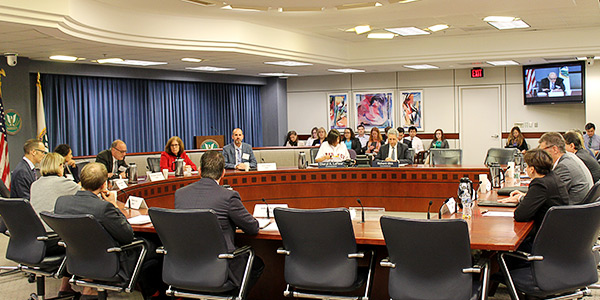By Michael Brooks
WASHINGTON — Observers of FERC’s technical conference on grid operators’ preparations for winter on Thursday would be forgiven if they experienced deja vu.
Most of the RTOs say they are ready; CAISO is keeping an eye on natural gas storage levels but not concerned; and the possibility of fuel shortages during an extended cold spell is keeping ISO-NE officials up at night.
The regions gave similar reports to FERC in 2017 and 2016. (See RTOs Brief FERC on Winter Preparations.)
“You know, I feel like we’re in a long-running production of ‘same time next year,’ where every fall you come and say, ‘We have plenty of capacity, we might not have enough gas, I’m cautiously optimistic we can make it through,’” FERC Commissioner Cheryl LaFleur told Peter Brandien, ISO-NE vice president of system operations.

Commissioners Cheryl LaFleur and Richard Glick | © RTO Insider
The National Oceanic and Atmospheric Administration is predicting a warmer-than-normal winter for most of the U.S., including New England. But Brandien said it is not the average temperature that concerns him; it’s the duration of low temperatures.
“It’s not that the electric load increases; it’s that the fuel kind of disappears” because home heating takes priority over electricity generation, he said. “Last winter, December, January and February were all above average temperatures and weather. But we experienced extreme cold weather Dec. 26 through Jan. 8, and it’s those kind of spells that cause us concern.”
When gas is short, ISO-NE relies on oil as backup fuel. But severe weather can cause delays not only for barges shipping in LNG, but for trucks carrying barrels of oil. Generators burning oil also face emission limits.
In their presentation to commissioners during their open meeting earlier that day, FERC staff also noted this will be the first winter under ISO-NE’s Pay-for-Performance capacity construct, which became effective June 1. The program is intended to better incent generators to perform during scarcity and emergency conditions, and influenced PJM’s Capacity Performance construct.
Staff also noted ISO-NE’s integration of price-responsive demand into its markets, also implemented June 1. (See ISO-NE Begins Real-time Dispatch of Demand Response.)

From left, Peter Brandien, ISO-NE; Emilie Nelson, NYISO; Dave Souder, PJM; Rob Benbow, MISO; Bruce Rew, SPP; and Nancy Traweek, CAISO. | © RTO Insider
But being the first years of these programs, Brandien said anything beyond a weeklong cold spell was unknown territory for the RTO.
No Worries Elsewhere
Representatives from the other FERC-jurisdictional grid operators reported that they were able to maintain reliability last winter despite two major cold snaps in January — one including the so-called bomb cyclone — and that they were similarly prepared for this winter.

FERC staff on Thursday led a technical conference on RTOs’ and ISOs’ reliability preparations for the upcoming winter. | © RTO Insider
Emilie Nelson, NYISO vice president of market operations, also referenced the late December/early January cold snap, which led to the ISO’s third highest winter peak load since 2004, at about 25.1 GW. Nelson said NYISO does not expect any problems this winter, but it is undertaking several efforts to plan for the long term. One of these is a fuel security study next year “to evaluate the ability to meet electric system needs during stressed system conditions, such as prolonged cold weather events and disruptions in fuel availability.” (See related story, NY Ready for ‘Average’ Winter; Burman Worried.)
Both Robert Benbow of MISO and Bruce Rew of SPP noted the mid-January cold snap in the South, when both MISO South and SPP set new all-time winter peaks on Jan. 17 of 32.1 GW and 43.6 GW, respectively.
While MISO maintained reliability through the event, Benbow said the RTO saw opportunities to improve its coordination with members and neighbors. Those lessons helped improve performance during a maximum generation event in September attributed to a major load forecasting error, he said. (See MISO: Sept. Emergency Response Improved by Jan. Event.)
Nancy Traweek, executive director of system operations for CAISO, said nothing has changed in regards to gas since last winter. Two pipelines in California — Southern California Edison’s Line 235-2 and Line 4000 — remain out of service, and her “favorite friend,” the Aliso Canyon storage facility, is still a last-resort resource for withdrawals. Rather than winter, Traweek said, the ISO is still concerned about summer.
“Right now we’re still considered in summer; it’s very warm and dry in California, and really the biggest risk we have right now is the risk of wildfire,” Traweek said. “It’s becoming a year-round issue. It used to be October would be our big wildfire season, and now we can see it any time of the year.”



